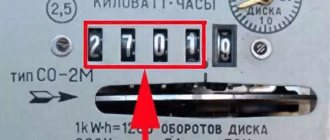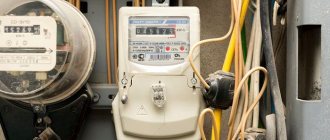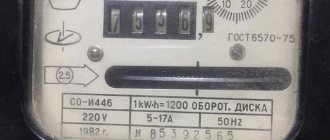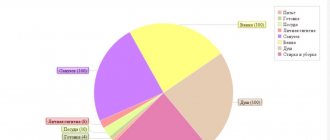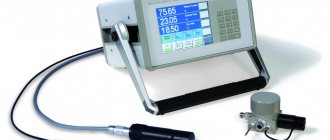Peculiarities
Electricity metering devices with a remote data transmission system relieve the user of the need to take readings, calculate consumed kilowatts and pay for them. After installing a remote-controlled electric meter, the electricity supplier receives from the consumer complete information about the resource consumed without the latter’s participation. The functionality of the devices allows you to monitor the level of electricity consumption and adjust the operation based on the data received, increasing efficiency.
How to transfer data on meters with an automated system
Electric meters with readings transmission require minimal human participation in the process. You only need to press a button once a month, and the data from the metering device is already sent to the desired address. However, automated sending of electric meter readings is even more convenient. The owner sends data to the server only once on his own. Subsequently, the controller itself performs this work. Here's how it happens.
Soon energy supervision controllers will no longer have to walk through the entrances with checks - all the data will be in the PC
After installing the equipment, the consumer transmits the indicator by pressing the button of the automatic data transfer device or directly on the website. Sometimes readings need to be sent only once, sometimes several times, every 5÷10 minutes. These actions are carried out before receiving a message from the energy supply or control company that the data has been received. From this moment on, you don’t have to take any action - all information will be sent to the desired address automatically. The electricity meter archives data every hour and sends it once a day.
By installing such equipment, you can forget about queues at the offices of management companies
Purpose
Remote transmission of electricity meter readings is carried out via the Internet. Special software reads and sends the necessary information to the servers of the energy supplier. Such systems are fully automated and do not require human intervention in the work process.
Electricity meters with remote readings and transmission are used to automate the processes of collecting and sending information and analyzing energy consumption. Energy supply companies that use information and measurement systems in their work receive not only data on the electricity consumed by customers, but also a number of opportunities that are not available when using standard metering devices. These include:
- Several tariff modes of operation.
- Remote connection and disconnection of the consumer to the power supply system.
- Effective and close cooperation with the client based on the terms of the drawn up contract.
- Guaranteed delivery of notifications to the consumer.
- Analysis of collected information for more efficient operation of the device.
Features of electricity meters with remote readings
The difference between transmitting electricity meters and simple ones is the presence of a microcontroller and data transmission system, which enable energy supply companies to remotely monitor energy consumption and even turn off its supply to the apartment in case of non-payment. To transmit electricity meter readings, no action is required from the owner - only initial setup and transmission of the first readings.
Such electricity metering devices are capable of transmitting readings themselves
Functions of the information and measuring system
The task of the information-measuring system is to collect, analyze and transmit information about electricity consumption to the supplier or controlling organization. It provides the ability to turn off or restore the supply of electricity by the supplier, or even limit power if the consumer exceeds the limit under the contract.
Interesting information! Using the analysis performed by the information-measuring system, it independently warns the consumer by sending information messages by email or personal account on the company’s website.
Electrical circuit diagram of a device for automatic data transfer
Advantages of electricity meters with remote readings
Electric meters with remote readings have a number of advantages over conventional meters. Let's look at some of them:
- Daily recording of data allows you to resolve controversial situations - if questions arise regarding accruals.
- Instant fixation of tariff switching. In the case of conventional multi-tariff meters, situations of untimely switching arise. In this case, the energy sales company resolves disputes not in favor of the owner.
- Additional protection. Often the owner forgets to turn off the iron or electric stove, remembering this at work or while traveling. Using an electricity meter with data transmission, you can turn off the power supply from any point using a smartphone or computer connected to the Internet. Agree, it’s a good way to protect your home.
- Saves time. Recording readings and wasting time on data transfer is a luxury today given our pace of life.
Previously, such devices were installed only as common ones...
Advantages of electricity meters
The use of a remote-controlled electric meter entails certain advantages for the consumer:
- Quick resolution of disputes between supplier and consumer without conflicts. Electric meter readings are taken remotely every day, which eliminates most of the problems that arise when filling out receipts.
- Possibility of monitoring data from metering devices installed in remote premises, for example, a rented apartment.
- Efficiency and accuracy of calculations when changing tariffs. Charges for the resources provided are carried out based on the average value, provided there are no indications for the period of change in tariff plans. Metering devices allow you to avoid rounding of calculations in favor of energy companies.
- The function of remotely taking electricity meter readings allows you to use the equipment in smart home systems. Special software for mobile devices activates the heating system.
- Safety. Remote de-energization of housing via a computer or smartphone turns off electrical appliances left on when the owners are absent.
- Practicality. There is no need to remove and transmit data from metering devices.
How does an electric meter transmit readings work?
The main work takes place in three stages - consumption data is collected, sent to the server of an energy sales or control organization, analyzed and archived. The first stage is carried out by sensors that collect data on electricity consumption, and control over their operation and processing of the received information is carried out by the electronics of the metering device. There can be no more than 32 such sensors - the receiver is designed for this maximum number.
Next, the data is transferred for storage to the server, where it can be viewed in real time from your home computer or from any other point by logging into your personal account. This work is assigned to the controllers that transport the signal. They also display data on the liquid crystal display of the electricity meter.
The third stage is archiving and analyzing data on the server, controller and PC. In this case, special software must be installed on the computer that will allow you to process the information received. If there is no such software on your home PC, you can view the data only in your personal account on the website of the company exercising control.
Remote meter design
The operating principle of new electricity meters with remote data collection is based on converting analog signals into pulses, on the basis of which the amount of energy consumed is calculated. The main difference between electronic devices and induction devices is the absence of driven mechanical parts and wider functionality:
- A well-organized electricity consumption metering system.
- Increased input voltage interval.
- Saving and providing data for previous accounting periods.
- Connection to systems for collecting and sending information to the supplier.
- Power consumption measurement.
The design of a remote electricity meter is represented by the required details:
- Liquid crystal display.
- Timer with actual time display.
- Transformer.
- Connectors for connecting telemetry.
- Control and monitoring elements.
- Supervisor.
- Power supply.
- An optical port can be installed optionally.
The liquid crystal display of the electric meter with remote readings displays information about the amount of energy consumed, the actual date and time, the operating mode of the device and the tariff.
An independent power source ensures the operation of the meter's electronic circuit. A supervisor is connected to it, which creates a reset signal for the microcontroller, which occurs when the electric meter is turned on or off remotely. With the help of the supervisor, changes in the input voltage are monitored.
The clock function in some models is performed by a microcontroller. The part is equipped with a separate microcircuit that reduces the load and power consumption, which allows you to redirect energy to solve other problems.
You can connect an electric meter with a remote control to a personal computer or data transmission system using a telemetry output. Information is collected from the metering device via the optical port.
Meter device for remote transmission of electricity readings
Equipment designed for metering electrical energy is a kind of converter that converts an analog signal into a pulse frequency. By counting these pulses, the amount of electricity consumed is calculated.
If we compare electronic devices with induction-type devices, the differences affect not only the internal structure, in which there are no mechanical rotating elements.
A feature of a modern electronic type meter is its extensive additional capabilities.
The main distinguishing feature is the advanced functionality:
- increased time interval for input voltage;
- convenient organization of multi-tariff accounting systems;
- availability of a mode for viewing indicators for past periods (months);
- ability to measure power consumption;
- ability to connect to automatic data acquisition and transmission systems.
In terms of structural structure, a modern electronic type meter is a housing frame equipped with a measuring current transformer, a terminal block, and a printed circuit board. The latter serves as the basis for mounting the electronic component of the device.
Note! A large number of additional functions are determined by the presence of software in the device microcontroller. Similar components are present in almost all electricity meters of the modern generation.
The homeowner can turn off the power to the apartment by remotely turning off the electric meter
The structure of electricity meters that transmit readings remotely
The design of a modern electronic type meter consists of the following elements:
- LCD display;
- clock displaying real time;
- current transformer;
- telemetry output;
- bodies exercising control and management;
- a power source designed to serve the electronic circuit;
- supervisor;
- optical port, which can be installed optionally.
The LCD display is an alphanumeric multi-digit indicator. Its main function is to indicate the operating modes of the meter. In addition, the component displays information about consumed electrical energy, the current time, and the date.
The power supply provides voltage to the microcontroller and other components installed in the electronic circuit. A supervisor is directly connected to it, generating a reset signal for the microcontroller that occurs when the power is turned off or on. In addition, the supervisor monitors changes in input voltage.
The meter display shows the amount of electricity used, the current time and date
A real time clock is used to accurately keep track of the date and current time. In some modifications of counters, a microcontroller performs this option. In order to reduce the load on this part, most often a separate microcircuit is provided for such purposes. It saves microcontroller power consumption, directing this energy to more important tasks.
Using the telemetry output, the meter is connected to a personal computer or a remote data transmission system. The optical port is designed to take readings directly from the metering device.
Note! The optical port is not present in all devices. In some models it is involved in programming information.
Microcontroller and instrument functions with remote transmission of electricity readings
The most important part of the device is the microcontroller. It performs most of the functions:
- converting the input signal coming from the current transformer into digital data;
- mathematical information processing;
- displaying the result;
- receiving commands from governing bodies;
- interface management.
The device may turn off if the assigned energy limit is exceeded
The list of microcontroller functions depends on the installed software. Today, active work is being carried out to improve such equipment, which consists of adding additional functions. These options include the ability to monitor the state of the power grid, while transmitting data to the control center.
Often meters have a function that allows you to limit the power level of the network. If the power consumption is exceeded, the device automatically interrupts the electricity consumer's access to the network. This system operates through a contactor that controls the voltage supply. The device can also turn off if the consumer exceeds the assigned energy limit or runs out of prepaid electricity funds.
Note! Some modifications of electricity meters are equipped with readers that accept plastic cards. They are intended to replenish your balance. This category of devices includes models STK-3-10 and STK-1-10.
Most electronic meters have a module installed for connecting an automated accounting system
Monitoring system in electricity meters with remote readings
Automated systems designed to monitor electrical energy records have been developed thanks to the advent of microprocessors at an affordable cost. The price of these devices was relatively affordable, so only large enterprises in the industrial sector could afford to install such equipment.
With the invention of electronic meters and PCs, automated accounting systems have taken a significant step forward. Thanks to the introduction of cellular communications, wireless systems have been created.
Automated accounting systems perform the following functions:
- collection of electrical energy flows over a reasonable period of time at all voltage levels;
- processing of received information;
- generating reports on supplied or consumed power (electrical energy);
- analysis and forecasting of generation (consumption);
- processing payment indicators;
- performing calculations for electrical energy.
A GSM communication system is used to transmit data from the meter
To organize an automated accounting system, you need to perform the following steps:
- Install high-precision accounting equipment. For this purpose, electronic meters are installed at electricity metering points.
- Transmit digital information (signals) to blocks with built-in memory. They are called "adders".
- Create a communication system, for example, GSM. It will be used for data transfer.
- Create data processing centers and equip them with computers with appropriate software.
Note! Today, many electronic meters have a built-in interface for connecting an automated accounting system. Even those devices that do not provide such an option allow you to install an optical port designed to take readings locally.
Electricity consumption is measured in meters that remotely transmit indicators every hour
Microcontroller
The main element of the counter is the microcontroller. It performs the following functions:
- Data processing.
- Converting the current received from the transformer into digital information.
- Displaying information on a liquid crystal display.
- Receiving commands from main control systems.
- Working with interfaces.
The installed software affects not only the possibility of programmatically slowing down the electric meter with remote readings, but also the number of functions. Modern models of metering devices are constantly being improved and equipped with new functions. Among the latest options is the ability to monitor the state of the power grid and transfer the collected information to the electricity supplier.
Some models of electric meters with remote readings are equipped with a function for adjusting the network power level. The device automatically turns off the power supply if power consumption increases. The voltage supply to the household network is controlled by a contactor embedded in the circuit. The device turns off the power supply when the established limit is exceeded or there is no prepayment for the provided resource.
Control system
The advent of microprocessors made it possible to create automated electricity metering systems. Previously, such devices were installed only in industrial enterprises due to their high cost. The advent of cellular communications and the widespread introduction of computers and electronic meters made it possible to create wireless automatic accounting systems.
Automated systems perform the following tasks:
- Collection of information about energy flows over certain periods of time and at all voltage levels.
- Analysis of collected data.
- Creation of reports on the provided and received resource based on the information received.
- Analysis of power consumption and its forecasting.
- Processing payment information.
- Carrying out calculations for electricity.
The organization of automated data collection systems requires the implementation of certain measures. High-precision equipment is installed to keep track of electricity. Data is loaded into special blocks with built-in memory. The data transmission system is formed after all actions have been completed. Creating an information processing center and equipping it with a personal computer with installed software is the final stage.
The principle of operation of electric meters with remote readings
The functionality of automated data transmission systems includes:
- Collection of information.
- Transfer of data to the supplier.
- Analysis and storage of information.
Data collection is carried out by special devices that measure system parameters. Such devices include sensors, the connection of which to an automated system is carried out using digital or analog converters or a special connector.
The resulting digital or analog signal is transmitted by microcontrollers between interface lines. This is required for data collection by a PC or controller. A server, personal computer or controller is connected to the process at the last stage and is responsible for collecting, processing and storing data. Performing such functions is only possible with software.
Automated Data Systems
Remote reading of electric meter readings and their transmission can be carried out not only by electronic, but also by induction devices. Models marked “D” are equipped with a connector for connecting telemetry. This output is represented by a pulse sensor that transmits information to a system that collects, processes and stores the received data.
The measuring transformer produces pulses by emitting magnetic fluxes and crossing an aluminum disk. They are transmitted to an electronic circuit, and then to the communication line feeding the meter. The photo-LED sensor head is directed towards the aluminum disk. The signal emitted by the LED is reflected from the disk and detected by a photodiode. Signal intermittency depends on the dark sector of the disc.
The meter's electronic circuit processes the signal interruption data, converting it into pulses and transmitting it to the communication line. The receiving device calculates their number over a certain period of time and displays the resulting value on the liquid crystal display.
How to transmit electricity meter readings with an automated system
The process of sending data is carried out without the participation of the subscriber. He is only responsible for transmitting the first indicator. This data must be reported until the manufacturer sends notice that it is no longer necessary. Electricity consumption in such meters is measured every hour. Once a day, the information received is sent to the controlling organization. Some models use mobile communications.
How do electricity meters that transmit readings automatically work?
The simplest automated data transfer systems operate in stages:
The main participants in the first stage are the devices that measure system parameters and the electricity meters themselves. The category of measuring devices includes all kinds of sensors that are connected to the system via analog-to-digital converters or equipped with an output used to connect an interface.
An automated system collects data, analyzes it and stores it on the server
The interface line used to transmit the information signal has an input impedance of 12 ohms. Since the power capabilities of the transmitter are limited, similar restrictions are imposed on the number of receiver devices that are connected to this line. The maximum number of sensors for which the receiver is designed is 32.
At the second stage, controllers come into operation, transporting the signal between the interface lines. This procedure is necessary for reading information by a controller or personal computer. If more than 32 sensors are involved in the connection, then hubs are installed in the system.
The third stage involves the server, PC and controller, which collect data, analyze it and save it. The system must have appropriate software that allows it to be configured.
Both electronic and induction devices are used to transmit indicators remotely
Induction type electricity meters and automatic data transmission systems
Not only electronic devices can be used to transmit indicators remotely. Induction devices marked with the letter “D” are equipped with a telemetric output. Essentially, this output is a pulse sensor. The category of such devices includes the SRZU-I670D model. Due to the pulse sensor, information is transmitted within a two-wire communication line to a system that collects and processes data. The information contains data on active electricity that passes through the device.
The pulse source is a measuring transformer. It emits a magnetic flux that crosses a metal sector mounted on the axis of an aluminum disk. Next, these pulses are transmitted to the sensor circuit, and then to the communication line that powers this sensor.
A photo-LED head is installed on the pulse sensor. It is a pair consisting of an LED and a photodiode. The sensor inside the electric meter has a specific location. The device is installed so that the head is turned towards the aluminum disk. The LED emits a signal that is reflected by the disk and then received by a photodiode. The darkened sector on the disk provides signal intermittency.
These interrupts are monitored by an electronic circuit, converted and sent to the communication line in the form of a sequence of pulses. The receiving device then receives them, counts the quantity over a certain period of time and displays the result on the display.
Electric meters with remote data reading require an uninterrupted connection to the network
Why are electronic meters beneficial when transmitting readings for light?
The previously described induction meter system is theoretically possible, but in practice it makes no sense. Such devices are gradually withdrawn from service and replaced by electronic ones. The exception is locally located accounting equipment.
Electronic devices have significant advantages regarding the creation of automated systems for transmitting readings, which are determined by the information component and extensive service capabilities.
The disadvantages of such equipment include the need for a constant connection to the network. When leaving for a long time, you cannot use the fuse to turn off the meter. There is a special switch for this purpose. The exclusive factor is electrical installation work. Otherwise, the operation of electronic meters that independently transmit readings is accompanied by benefits for the user.
Transfer of readings
The resource supplier receives data from the electricity meter, bypassing the energy company and the consumer. The client is required to provide the very first readings. Electric meters with remote readings work as long as there is a need for it.
Electricity consumption calculations are performed hourly. The collected data is sent to the supplier once a day. Some models of pole-mounted remote electricity meters are equipped with SIM cards, through which data is sent to energy companies.
Electric meter transmitting readings: features of devices
Meters equipped with a remote reading system are suitable for apartment owners who do not want to think every month about how and where to transfer the received meter readings. If a consumer of electrical energy has a similar device installed at home, data transfer will be carried out automatically without direct human participation.
The use of meters with remote data transmission is convenient for both apartment owners and enterprises
Sending charged kilowatts does not take much time, and the process itself is comfortable and convenient. Enterprises involved in the supply of electricity can use these devices to monitor the level of energy consumption by the population.
In a global sense, electric meters that are capable of transmitting information remotely make it possible to rationalize energy consumption and achieve efficient operation of the entire system, starting with energy production, ending with its consumption and processing data for paying utility bills using networked information and measuring systems.
Purpose of information and measuring systems
Network systems designed to collect measurement information on meter indicators organize the process of remote data transfer from metering equipment via the Internet. The operation of such systems is automated. The software reads the information and then sends the received data to the server of the energy supply company.
Data on meter readings is automatically sent via the Internet
Information and measuring systems are used to automate the following processes:
- collection of information;
- data transfer;
- analysis of energy consumption indicators.
The use of information and measurement systems by energy supply companies not only gives them access to indicators of electrical energy consumption, but also provides a number of additional functions. This includes the following options:
- operation of accounting equipment in multiple tariff modes;
- connecting or disconnecting an electricity consumer remotely;
- individualization of work with the consumer of electrical energy, taking into account the terms of the signed agreement;
- forwarding warning notifications;
- effective analysis of collected information, etc.
One of the benefits of using a smart meter is energy consumption analysis
Benefits of automatic transmission of electricity meter readings for users
By installing meters in your apartment that have the function of automatic remote data transmission, the homeowner receives many benefits. Advantages of the system for users:
- resolution of controversial situations - meter readings can be recorded every day. This data transmission scheme allows you to eliminate conflict situations if problems arise with receipts or the subscriber does not transfer information regularly;
- control of readings - metering devices provide the opportunity to take readings from places that the consumer rarely visits, for example, from a rental apartment, garage or country house;
- high accuracy of calculation during tariff switching - if there is no indication on the date of tariff change, energy companies make charges based on average indicators. As a rule, settlement is carried out in favor of the supplier company. Using metering devices with a remote transmission function allows you to avoid such problems;
A meter with an automatic counting system will be convenient for users who use several electricity metering tariffs
- remote control of the meter - the equipment can be used to preheat the home. It is enough to connect the device a couple of hours before arriving home so that the heating system warms up the premises before arrival. To do this you will need a smartphone;
- safety – if the homeowner forgets to turn off an electrical appliance, such as an iron or stove, there is no need to return home. It is enough to turn off the power to the apartment by remotely turning off the meter;
- practicality and time saving - the user does not need to waste time and effort on taking readings, queuing at cash registers or transmitting information using standard methods.
The energy company can remotely disconnect the consumer from electricity
Advantages of remote metering devices
In practice, data transmission via induction meters is not used. Such devices have recently been replaced by electricity meters with remote controls with the possibility of use in automated information transmission systems.
The disadvantage of electric meters equipped with a radio module is the need for constant power supply from the network and the inability to use fuses to turn off the device. For this purpose, a special cut-off device is installed.
Meter manufacturers
Electric meters with remote control have been in use for many years, which requires the selection and installation of high-quality and reliable equipment. Consumers try to choose products from proven brands, Inotex and Energomera.
The Russian company has been specializing in the production of electronic equipment and metering devices for fifteen years. It occupies a leading position in the Russian market.
Energomera appeared on the domestic market in 2010, almost immediately conquering a considerable part of the market thanks to the high quality of the devices produced.
Founded in 1999 in St. Petersburg, it specializes in the production of measuring equipment, including electricity meters with remote readings on a pole.
Information for consumers of Krasnogorskenergosbyt JSC
From April 1, 2020, on the basis of Order of the Ministry of Energy of the Russian Federation dated March 20, 2020 No. 211 “On assigning the status of a last resort supplier to a territorial grid organization”, the status of a last resort supplier of electrical energy in the area of activity of the joint stock company Krasnogorskenergosbyt (JSC IES) of the city district Krasnogorsk, Moscow Region, is assigned to the Public Joint Stock Company “Moscow United Electric Grid, operating under the brand “Rosseti Moscow Region”).
In the current circumstances, PJSC "MOESK":
1. From April 1, 2020, I organized the reception of consumer meter readings by phone 8 (800) 700-40-70 and on the website sbyt.moesk.ru.
2. From 04/06/2020, he organized and will carry out mass reprogramming of metering devices with a prepayment function no later than 05/31/2020. In accordance with the norms of the current Legislation of the Russian Federation, automatic limitation of energy supply in case of reaching a zero balance on a prepaid card is ILLEGAL, as evidenced by the decision of the Office of the Antimonopoly Service for the Moscow Region back in 2009 (resolution dated June 30, 2009 No. 05-15/08-09 ), as well as the decision of the Federal Arbitration Court of the Moscow District (resolution No. KA-A40/6187-10 dated June 23, 2010). Reprogramming activities are carried out by visiting each consumer and transferring the meter installed to him into postpayment mode (classic mode, in which the prepayment balance will not be taken into account). To return the overpayment, all consumers who have a balance of unspent prepaid funds will have to independently contact IES JSC with an application for a refund of funds to the consumer or transfer to a new guaranteeing supplier. For your convenience, we suggest using the application form for the return of overpaid funds, posted on the website of PJSC "MOESK" at the link. A sample of the completed application can also be viewed on the website via the link. If your meter has not yet been reprogrammed, but the prepayment balance is close or has already reached zero, you can contact PJSC “MOESK” by phone and leave a request to reprogram the meter due to the threat (or fact) of energy supply restrictions. In order to avoid unreasonable restrictions on energy supply, we recommend that you do not wait for the prepaid funds to be completely spent and leave a request for reprogramming no later than one day before the expected reset of the prepaid balance.
3. In order to organize high-quality customer service, I entered into an agency agreement with the largest energy retail company, including:
3.1. Organization of a personal client account (LKK - my.mosenergosbyt.ru) allowing consumers to transmit meter readings, view the history of meter readings, receive receipts for electricity payments and pay for issued receipts, submit electronic applications for data correction to LKK, including including applications for recalculation, as well as other applications related to ensuring reliable energy supply (checking metering devices, permission to operate, etc.);
3.2. Organization of customer service through the My Mosenergosbyt mobile application (https://clc.to/moymesdistance);
3.3. 24-hour customer service by phone 8 (499) 550-9-550 and 24-hour readings by telephone on a dedicated line +7 (499) 550-9-550.
4. New Personal accounts were automatically generated for all consumer citizens to carry out mutual settlements with PJSC MOESK. You can find out the new Personal Account number on the website of PJSC "MOESK" in the section, indicating the number of the Personal Account that you had at JSC "IES". You will need a new Personal Account number when registering in the Client’s Personal Account on the Mosenergosbyt JSC website (my.mosenergosbyt.ru).
5. Payment for electrical energy consumed starting from April 1, 2020 must be strictly addressed to PJSC "MOESK" using the following details: Recipient: PJSC "MOESK" INN 5036065113 KPP 997650001 Current account: 40702810638000257329 Bank: PJSC "Sberbank" BIC 044525225 Bank account 30101810400000000225 Electricity bills with new details will be issued in the first ten days of May 2020 and delivered to mailboxes. Before paying the invoice, check whether the details on the receipt match those indicated in this leaflet.
6. If you have any questions, you can ask them by phone (PJSC MOESK) or 8 (499) 550-9-550 (JSC Mosenergosbyt).
FAQ
Question: Where can I go to resolve issues regarding power supply?
Answer: For all questions, consumers can contact the “Bright Line” of PJSC “MOESK” at round-the-clock number 8 or Contact at round-the-clock number 8 (499) 550-9-550. For your convenience and to resolve emerging issues of Mosenergosbyt JSC, after the lifting of restrictive measures related to the spread of coronavirus infection, consumers - individuals will be able to contact the Customer Service Center at the address: Krasnogorsk, st. Dachnaya, 11a, 5th floor. Office hours are Mon-Fri from 9:00 to 18:00.
Question: Will a change in the supplier of last resort lead to a change in electricity tariffs or terms of supply?
Answer: No. Changing the supplier of last resort will not lead to an increase in electricity tariffs or a change in the terms of its supply.
Question: Do I need to renew the energy supply agreement with PJSC MOESK? And where can I get acquainted with it?
Answer: No. For individuals, renewing the energy supply contract is not required. The agreement with PJSC "MOESK" is considered concluded automatically from 04/01/2020. You can familiarize yourself with the terms of the agreement on the website of PJSC "MOESK" in the section.
Question: I am going to transfer the readings from the metering devices to PJSC MOESK. How can i do this?
Answer: Currently, you can submit meter readings in one of the following ways:
1. In your Personal Account on the website my.mosenergosbyt.ru. 2. Using the chatbot of Mosenergosbyt JSC on the website www.mosenergosbyt.ru and Viber. 3. By phone: 8 (499) 550-9-550; 4. When making payments through Sberbank channels (including Sberbank Online).
In order to generate correct charges for consumed electricity, meter readings must be submitted from the 15th to the 26th of each month. In case of failure to provide evidence, accrual will be carried out in accordance with the current norms of the Legislation (according to the average, according to the standard).
Question: How can I register in the Client's Personal Account?
Answer: Consumer-citizens who transferred from JSC IES to PJSC MOESK can register in the Personal Account of the client of JSC Mosenergosbyt (my.mosenergosbyt.ru). JSC Mosenergosbyt provides services to consumers of PJSC MOESK on the basis of an agency agreement between JSC Mosenergosbyt and PJSC MOESK. After registering in the Client’s Personal Account (LCA), the user will be able to link the consumer’s Personal Account to his account (if the consumer has several Personal Accounts, then it will be possible to link all the Personal Accounts for which the consumer pays for electricity at PJSC “MOESK”). The Personal Account number is indicated on payment receipts sent to consumers in paper format. In addition, the Personal Account number can be found on the website of PJSC "MOESK" in the section, indicating the number of the Personal Account that you had at JSC "IES". To link your Personal Account, you will also need to indicate the amount payable for electricity indicated in receipts starting from April 2020. If the consumer has not received a receipt in paper format, he can check the amount to be paid with the Contact operator by calling 8 (499) 550-9-550. ATTENTION! To transfer a call to an operator, you must say the word “Operator” span>.
Question: I registered in the Client's Personal Account. The consumer information specified in the LCC is incorrect. Can I change it?
Answer: Yes. You can submit an application in the client’s Personal Account, indicating the necessary adjustments and attaching scanned copies or photographs of supporting documents.
Question: I did not have time to timely submit to PJSC MOESK the meter readings as of April 1, 2020. Can I do this now and can I adjust my electricity bill based on these readings?
Answer: Yes. If you did not manage to timely submit to PJSC MOESK the meter readings as of April 1, 2020, you can submit an application for recalculation in the client’s Personal Account (my.mosenergosbyt.ru) indicating the meter readings as of April 1, 2020. The calculation adjustment will be made no later than the next billing period, and the adjusted receipt itself will be posted in your Personal Account in electronic form. Please note that for the calculation, readings are required at the beginning of the period (i.e., April 1, 2020) and at the end of the period (i.e., readings no later than the 26th day of the billing month).
Question: I received a receipt in which the charge for electricity was made according to the standard. Is it possible to recalculate according to indications and what is needed for this?
Answer: Yes. If you have received a receipt in which the accrual has been generated according to the standard, you can submit an application for recalculation in the client’s Personal Account (my.mosenergosbyt.ru) indicating the initial and final readings for the calculation. Calculation based on readings can be carried out only if there are initial (for April – as of 04/01/2020) and final (from the 15th to 26th of the month) readings. Please note that in order to make calculations based on readings, the consumer must ensure that readings are transmitted monthly from the 15th to the 26th of the billing month.
Question: I submitted meter readings to PJSC MOESK from April 1 to April 10, 2020, as well as from April 15 to April 26, but they were not taken into account and were not reflected in the receipt I received for April 2020. Is it possible to take into account the readings I provided and adjust the calculation for consumed electricity based on these readings?
Answer: Yes. If you have received a receipt for payment of electricity that does not take into account the readings you submitted, you can submit an application for recalculation in the Client’s Personal Account (my.mosenergosbyt.ru) indicating the meter readings as of April 1, 2020. The calculation adjustment will be made no later than the next billing period, and the adjusted receipt itself will be posted in your Personal Account in electronic form. Please note that for the calculation, readings are required at the beginning of the period (i.e., April 1, 2020) and at the end of the period (i.e., readings no later than the 26th day of the billing month).
Question: How can I find out whether the verification period (inter-verification interval) for the electricity meter installed on me has expired?
Answer: The timing of the verification intervals for metering devices installed at consumers in the coverage area of IES JSC is published on the website of PJSC MOESK ( ) in the section “Calibration intervals for individual electricity metering devices”. You can determine whether the verification period for your metering device has expired by comparing its type and year of manufacture (or the date of the last verification indicated in the metering device’s passport) with the data published on the website. Additionally, we draw your attention to the fact that in connection with the entry into force of Decree of the Government of the Russian Federation No. 424 dated 04/02/2020, the procedure for applying sanctions for the use by consumers of metering devices with an expired verification period has changed. According to the decision of the Government of the Russian Federation, until 01.01.2021, upon expiration of the verification period (inter-verification interval), the metering device cannot be considered out of order, and therefore is recognized as suitable for further use as a calculation device when determining the volume of electricity consumed. Thus, at the moment you do not need to verify the metering device or replace it if the verification period has expired. In case of changes to this norm of the Legislation, consumers will be separately informed.
Question: Am I required to carry out verification or change the metering device if its verification period has expired?
Answer: No. In connection with the entry into force of Decree of the Government of the Russian Federation dated April 2, 2020 No. 424, the procedure for applying sanctions for the use by consumers of metering devices with an expired verification period has changed. According to the decision of the Government of the Russian Federation, until 01.01.2021, upon expiration of the verification period (inter-verification interval), the metering device cannot be considered out of order, and therefore is recognized as suitable for further use as a calculation device when determining the volume of electricity consumed. Thus, at the moment you do not need to verify the metering device or replace it if the verification period has expired. In case of changes to this norm of the Legislation, consumers will be separately informed.
Question: What happens if I do not replace or do not verify a meter with an expired verification period?
Answer: Even if your meter has expired, the amount of payment for electricity, by virtue of Government Decree No. 424 dated 04/02/2020, will be based on the meter readings provided by you. In the absence of meter readings, payment for electricity will be calculated according to the standard. In order to avoid increasing electricity bills, PJSC "MOESK" recommends that you submit meter readings to PJSC "MOESK" monthly from the 15th to the 26th of each month.
Question: Who verifies metering devices? Can PJSC "MOESK" itself carry out verification of the metering device?
Answer: According to clause 2 of Article 13 of the Federal Law of June 26, 2008 No. 102-FZ “On Ensuring the Uniformity of Measurements”, verification of measuring instruments is carried out by legal entities and individuals accredited in accordance with the legislation of the Russian Federation on accreditation in the national accreditation system for verification of measuring instruments entrepreneurs. PJSC "MOESK" is not an accredited organization authorized to carry out verification of metering devices. Please note that in connection with the entry into force of the Government of the Russian Federation Decree No. 424 dated 04/02/2020, the procedure for applying sanctions for the use by consumers of metering devices with an expired verification period has changed. According to the decision of the Government of the Russian Federation, until 01.01.2021, upon expiration of the verification period (inter-verification interval), the metering device cannot be considered out of order, and therefore is recognized as suitable for further use as a calculation device when determining the volume of electricity consumed. Thus, at the moment you do not need to verify the metering device or replace it if the verification period has expired. In case of changes to this norm of the Legislation, consumers will be separately informed.
Question: How can I verify or replace a meter whose verification period has expired?
Answer: If your metering device has expired the verification period, you can contact PJSC "MOESK" for a service to replace the metering device by phone. Based on your application, a contract for the provision of services for replacing the meter will be prepared. Please note that in connection with the entry into force of the Government of the Russian Federation Decree No. 424 dated 04/02/2020, the procedure for applying sanctions for the use by consumers of metering devices with an expired verification period has changed. According to the decision of the Government of the Russian Federation, until 01.01.2021, upon expiration of the verification period (inter-verification interval), the metering device cannot be considered out of order, and therefore is recognized as suitable for further use as a calculation device when determining the volume of electricity consumed. Thus, at the moment you do not need to verify the metering device or replace it if the verification period has expired. In case of changes to this norm of the Legislation, consumers will be separately informed.
Question: Is it true that responsibility for verification, installation, and replacement in the event of a malfunction rests not with the consumer, but with the electric grid/energy sales organization?
Answer: In connection with the entry into force of Decree of the Government of the Russian Federation dated April 2, 2020 No. 424, the procedure for applying sanctions for the use by consumers of metering devices with an expired verification period has changed. According to the decision of the Government of the Russian Federation, until 01.01.2021, upon expiration of the verification period (inter-verification interval), the metering device cannot be considered out of order, and therefore is recognized as suitable for further use as a calculation device when determining the volume of electricity consumed. Thus, at the moment you do not need to verify the metering device or replace it if the verification period has expired. In case of changes to this norm of the Legislation, consumers will be separately informed.
Question: From what period should I pay for energy supply services at PJSC "MOESK"?
Answer: According to the Order of the Ministry of Energy of the Russian Federation dated March 20, 2020 No. 211, the responsibilities of the guaranteeing supplier of electrical energy in the area of activity of IES JSC are assigned to PJSC MOESK from April 1, 2020. Energy supply services are subject to payment by the consumer to PJSC "MOESK" for the period starting from 04/01/2020 until the end of the period for PJSC "MOESK" to perform the functions of a guaranteeing supplier.
Question: Where do I need to pay for electricity for previous periods (periods before 04/01/2020)?
Answer: According to the Order of the Ministry of Energy of the Russian Federation dated March 20, 2020 No. 211, the responsibilities of the guaranteeing supplier of electrical energy in the area of activity of IES JSC are assigned to PJSC MOESK from April 1, 2020. Energy supply services for periods preceding 04/01/2020 are subject to payment by the consumer at IES JSC.
Question: Will PJSC "MOESK" recalculate the debt or charge penalties on the debt that arose during the period of fulfillment of the obligation of the guaranteeing supplier of JSC "IES" (until 04/01/2020)?
Answer: No. Consumer debt incurred before 04/01/2020 is subject to payment to IES JSC. PJSC "MOESK" will make payments for energy supply services starting from 04/01/2020.
Question: I have a prepaid meter installed (with a SMART card). Do I need to transfer meter readings to PJSC MOESK?
Answer: Yes. In order to ensure correct payments between the consumer and PJSC “MOESK”, you need to transfer the meter readings to PJSC “MOESK” that are current as of the beginning of April 2020, as well as ensure regular transmission of readings in the future. The amount of payment for electricity in the case of providing readings will be based on the provided meter readings. In the absence of meter readings, payment for electricity will be calculated according to the standard. In order to avoid increasing electricity bills, PJSC "MOESK" recommends that you submit meter readings to PJSC "MOESK" monthly from the 15th to the 26th of each month.
Question: I have a prepaid meter installed (with a SMART card). Do I need to change the meter?
Answer: No. There is currently no direct need to replace such a metering device. All metering devices with a prepayment function are currently being transferred (reprogrammed) by PJSC "MOESK" to postpayment mode. Replacement of the metering device will be required in the event of a malfunction of your metering device or in the event of a technical impossibility of reprogramming. However, in order to avoid disconnections upon reaching a zero balance on the prepaid card, PJSC "MOESK" recommends replacing the installed prepaid meter with a new meter without prepayment. You can contact PJSC "MOESK" for a service to replace the metering device by calling 8 (495) 787-97-40>. Based on your application, a contract for the provision of services for replacing the meter will be prepared.
Question: I have a prepaid meter installed (with a SMART card). How can I return the balance of unspent prepaid funds?
Answer: All consumers who have a balance of unspent prepaid funds will have to independently contact IES JSC with an application to return the funds to the consumer or transfer them to a new guaranteeing supplier to return the overpayment. For your convenience, we suggest using the application form for the return of overpaid funds, posted on the website of PJSC "MOESK" at the link. A sample of the completed application can also be viewed on the website via the link.
Question: I have a prepaid meter installed (with a SMART card). To avoid being disconnected when my prepaid card balance reaches zero, can I top up my prepaid card account?
Answer: Yes, however, you must understand that subsequently you will have to independently contact IES JSC with an application for a refund of overpaid funds. A receipt for payment for electricity will be issued by PJSC "MOESK" only taking into account the funds received in favor of PJSC "MOESK". If your meter has not yet been reprogrammed, but the prepayment balance is close or has already reached zero, you can contact PJSC “MOESK” by phone and leave a request to reprogram the meter due to the threat (or fact) of energy supply restrictions. In order to avoid unreasonable restrictions on energy supply, we recommend that you do not wait for the prepaid funds to be completely spent and leave a request for reprogramming no later than one day before the expected reset of the prepaid balance.
Question: I have a prepaid meter installed (with a SMART card). If the balance on a prepaid card reaches zero, will the consumer be disconnected?
Answer: Yes. Unfortunately, taking into account the design features of prepaid metering devices, the consumer is disconnected automatically upon reaching a zero balance on the prepaid card. If your meter has not yet been reprogrammed, but the prepayment balance is close or has already reached zero, you can contact PJSC “MOESK” by phone and leave a request to reprogram the meter due to the threat (or fact) of energy supply restrictions. In order to avoid unreasonable restrictions on energy supply, we recommend that you do not wait for the prepaid funds to be completely spent and leave a request for reprogramming no later than one day before the expected reset of the prepaid balance.
Question: I have a prepaid meter installed (with a SMART card). Can it be reprogrammed so that it does not honor the balance on a prepaid card?
Answer: Yes. Reprogramming the meter is possible. PJSC "MOESK" has been carrying out mass reprogramming of metering devices since 04/06/2020. The events will be held in full no later than 05/31/2020. If your meter has not yet been reprogrammed, but the prepayment balance is close or has already reached zero, you can contact PJSC “MOESK” by phone and leave a request to reprogram the meter due to the threat (or fact) of energy supply restrictions. In order to avoid unreasonable restrictions on energy supply, we recommend that you do not wait for the prepaid funds to be completely spent and leave a request for reprogramming no later than one day before the expected reset of the prepaid balance.
Question: I have a prepaid meter installed (with a SMART card). I had it reprogrammed. What is my current rate?
Answer: Reprogramming the meter does not lead to a change in tariffs. If your meter previously calculated according to 2 tariffs (day/night), then after reprogramming the meter will also calculate consumption according to two tariffs. Likewise for other situations.
Question: On the basis of what legislative acts is responsibility for replacing and checking metering devices assigned to consumers?
Answer: In accordance with Article 210, Part 1 and Article 290 of the Civil Code of the Russian Federation and in accordance with paragraph 34, paragraphs d, e and paragraph 81 of the Rules for the provision of utility services to owners and users of premises in apartment buildings and residential buildings, approved Decrees of the Government of the Russian Federation dated May 6, 2011. No. 354 “On the provision of utility services to owners and users of premises in apartment buildings and residential buildings”, responsibility for the proper condition of the meter and its verification rested with the consumer. However, by virtue of Decree of the Government of the Russian Federation dated April 2, 2020 No. 424, the procedure for applying sanctions for the use by consumers of metering devices with an expired verification period has changed. According to the decision of the Government of the Russian Federation, until 01.01.2021, upon expiration of the verification period (inter-verification interval), the metering device cannot be considered out of order, and therefore is recognized as suitable for further use as a calculation device when determining the volume of electricity consumed. Thus, at the moment you do not need to verify the metering device or replace it if the verification period has expired. In case of changes to this norm of the Legislation, consumers will be separately informed.
Question: I used the service to replace the metering device not at PJSC MOESK or at JSC Mosenergosbyt. What do I need to do to accept a new meter for calculations?
Answer: You can leave a request in the client’s Personal Account (my.mosenergosbyt.ru) for permission to put a new meter into operation. Until you obtain the permit, you need to keep the old metering device.
Question: It seems to me that my meter is counting incorrectly. Can I check the quality of the metering device?
Answer: You can leave a request in the client’s Personal Account (my.mosenergosbyt.ru) to check the metering device. ATTENTION: the service for checking the metering device is paid!
Popular models of metering devices
- Neva 103 1SO/"Taipit". Certified single-tariff model of an electric meter with a mechanical reading device. First class accuracy. The operating temperature range is from -40 to +60 degrees. The average price is 700 rubles.
- Mercury 201.8/"Inotex". Single tariff metering device with liquid crystal display. First class accuracy. Operates at temperatures from -45 to +75 degrees. Cost - from 600 to 750 rubles.
- CE102M S7 145-JV/"Energy meter". Universal multi-tariff electricity meter. Four working plans are available. First class accuracy. Operating temperature range - from -45 to +70 degrees. Price - from 1400 to 2100 rubles.
- Mercury 200.02/"Inotex". Commercial model of a multi-tariff meter. First class accuracy. The operating temperature range is from -40 to +55 degrees. Cost - from 1500 to 1800 rubles.
- Mercury 231 AM-01/"Inotex". Commercial model of a single-tariff meter. Three-phase voltage. First class accuracy. Operates at temperatures from -40 to +55 degrees. Price - from 2000 to 2500 rubles.
- CE300 R31 043-J/"Energy meter". Single-tariff electric meter with liquid crystal display. Three-phase voltage. The operating temperature range is from -40 to +60 degrees. Accuracy class - 0.5-1. Cost - from 2100 to 4400 rubles.
- Mercury 231 AT-01/Inotex. Universal model of a multi-tariff meter. Three-phase voltage. The operating temperature range is from -40 to +55 degrees. Support from 2 to 4 tariffs. First class accuracy. Price - from 2700 to 3220 rubles.
How to choose an electric meter?
The main indicators when choosing a remote metering device are:
- Protection from environmental influences.
- Number of supported tariffs for paying for electricity.
- Number of phases.
- Power.
Meters are divided into two categories according to the number of tariffs - supporting one or more. The classification by phase is similar - single-phase or three-phase models.
Induction meters are inferior to electric meters in terms of resistance to temperature changes and other environmental influences.
According to the PUE, a device placed outdoors must be insulated. Modern models of electric meters placed on poles with remote readings remain operational at low temperatures, but require protection from other factors. Operation should only be carried out in a sealed and dry place.
The design of the device affects the choice of box. Meters installed at low heights require a small window. Other models require free space to accommodate the modem. Metal ones must be grounded.
Individual consumption and building dimensions affect the number of phases. For a small house one is enough, for large buildings with several floors - three. Meters with three phases must be correctly connected to the common network to distribute the load evenly.
The mounting method and the date of the last inspection of the device are specified before its installation. Most often, meters are mounted using a DIN rail. The last check date for a single-phase model is no more than two years ago, for a three-phase model no more than a year ago.
The procedure for installing and connecting an electric meter
After agreeing on the procedure for connecting the electric meter, the electricity supplier company sends a qualified specialist who installs the device. Self-installation is only possible if safety precautions are observed and written permission is available.
Installation of an electric meter with remote reading begins with the submission of an application. The electricity supply company prepares a package of documents, including an installation certificate and a user agreement. The documents must indicate:
- Device type, number of supported tariffs and phases.
- Input protection device.
- Wire length and cross-sectional area.
- Name of the box.
Installation of the device is carried out only after the technical documentation is issued to the consumer. The following factors are observed during installation:
- Installation of equipment is carried out with the power supply turned off.
- The maximum height of the device is 1700 millimeters, the minimum is 400 millimeters.
- To protect the meter from exposure to low temperatures, a heating box is installed. The optimal temperature for the effective operation of the device is from 0 to 20 degrees.
- The input circuit is connected first to the circuit breaker, then to the meter.
- Metal enclosures require grounding.
- The output circuit is connected to the input circuit breaker.
- The minimum distance between water supply, gas supply and electricity lines is one meter.
- Before operating the electrical network, a test run is carried out.
A document granting the right to operate the metering device is issued after installation of the electric meter. The consumer draws up an application and sends it to the office of the supplier company. The paper states:
- Applicant's initials.
- Contract number.
- Contact phone number and house address.
- Date of registration, signature and transcript of the user's signature.
A representative of the electric company draws up an inspection report of the installed device. It indicates the cost of installation work and technical characteristics of the electric meter.
The device is sealed after the initial readings are taken at the expense of the resource supplier. Payment for the provided electricity begins from the moment the act is drawn up and the document is signed by the parties.

